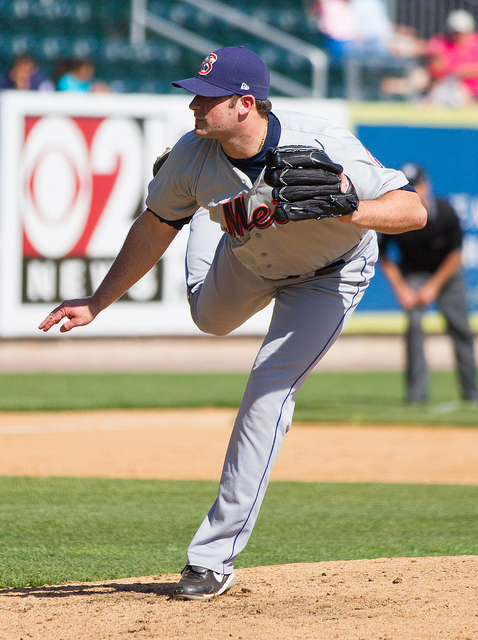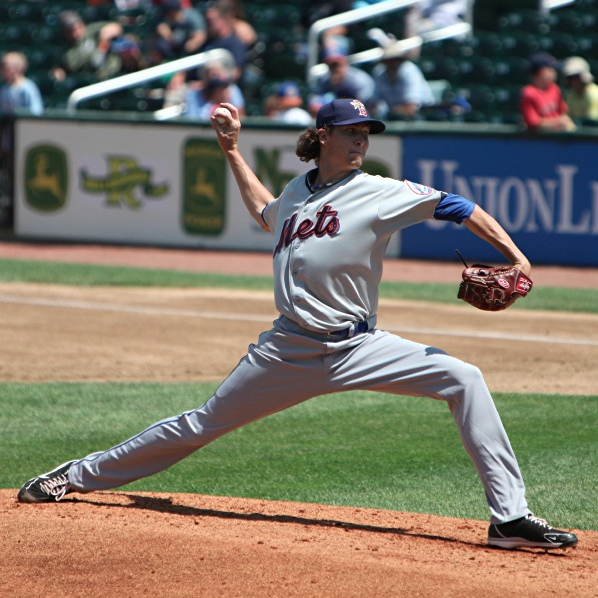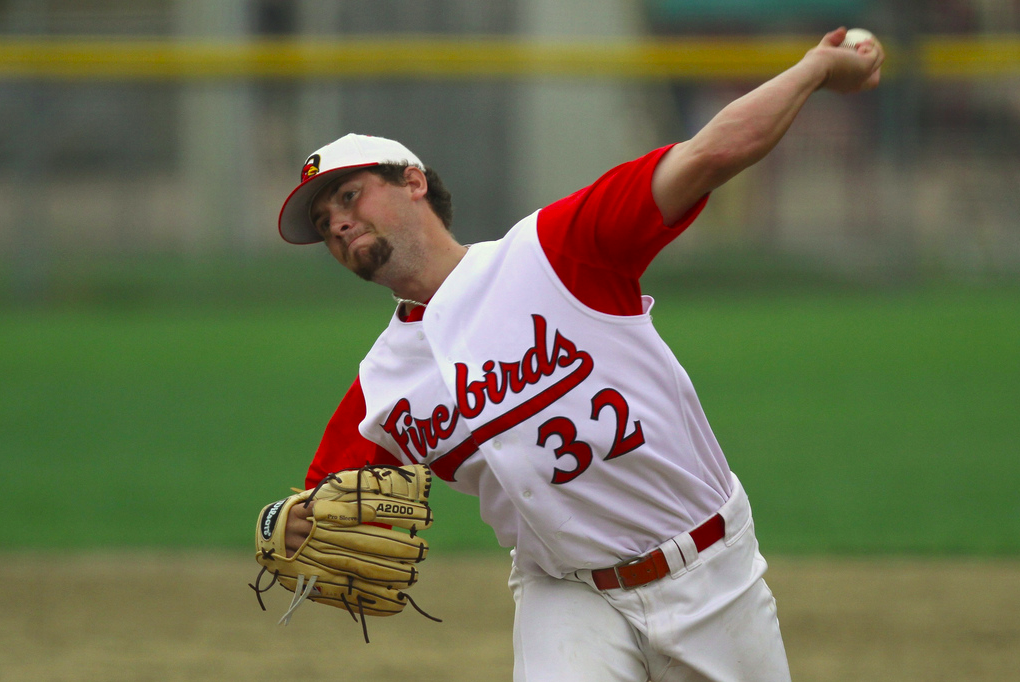
The highest level of the minors isn't typically a hotbed for prospects. However, the Mets featured a few potential impact players as well as a number of role players in Las Vegas in 2013.
Finally we've reached the end of the line in what has been at times an epic minor league season in review series. As always, this labor of love is one of the most illuminating recurring pieces of the year on this side of the keyboard -- hopefully the feeling is shared on the opposite end.
Today we'll look at the names to know that played in Las Vegas in 2013. As with our other stops, you can take a higher level look at the club and more on the storylines of their 2013 campaign with our affiliates overview. However, here we'll take a more player-centric look at the various prospects that played for the Mets new Triple-A affiliate last summer:
Hitters
Eric Campbell, IF/OF
It took him three tries in Double-A before he reached the next level. He'll be 27 years old to start the 2014 season. He still doesn't have a position of any note. And yet, Eric Campbell just keeps plugging away, utilizing a highly refined approach at the plate and a solid bat to show that he can help a major league club. The Norwich, Connecticut native had his best season in 2013, posting a .314/.435/.475 line -- no doubt helped by his environs -- where his stellar walk rate (15.5%) actually outshined his stellar strikeout rate (14.1%) -- not a common feat.
In a nutshell, the 2008 eighth-rounder out of Boston College is Josh Satin in almost every way. Whether it's the premier plate discipline, the solid hit tool, the toiling in the minors, the lack of a true defensive home, the mediocre power from the right side -- he's Satin. Unfortunately for Campbell, the Mets already have a Josh Satin; however, should a need arise due to injury, etc in any of the corners -- he split his time almost exactly equally between first, third, right field, and left in 2013 -- Campbell could very conceivably get his long-awaited first call-up in 2014.
Juan Centeno, C
Mets fans got a brief look at the 24-year-old backstop in his late season cup of coffee in 2013 and in many ways what they saw -- aside from this glorious moment -- was exactly what Centeno brings to the table as a prospect: a contact-oriented singles approach at the plate and excellent defense behind it. In those ways he's the catching equivalent of a Wilfredo Tovar -- perfectly suited for a role as the second-string at a position where defense counts more. Like Tovar, Centeno is the sort of hitter who looks like he could capably fill in for extended periods when the BABIP gods are feeling merciful. But again, he's a back-up.
Now despite his .305/.346/.371 line in 67 games in Las Vegas -- not to mention a nice showing in his first week with the big club and a bunch more singles on his way to a .280 mark in winter ball -- there's a good chance Centeno doesn't actually start the year in that role for the Mets. Thanks to the presence of fellow neophyte Travis d'Arnaud, the club will likely prefer more of veteran presence in a back-up -- someone who counterbalances d'Arnaud's inexperience and can potentially instill catcherific wisdom. For that reason, look for Centeno to begin the year back in Las Vegas -- but expect him to get the call should a need arise behind the dish. On a side note, the fact that we're talking about the 2007 32nd-rounder out of Puerto Rico as a major league option at all is a nice win for the organization.
Matt den Dekker, OF
2013 was a relatively good season for the 26-year-old den Dekker who got a late start thanks to a broken wrist suffered in spring training but performed well once he made it to Las Vegas then made his major league debut late in the summer. Though he batted just .207 with one home run in 63 sporadic plate appearances with the Mets, the athletic lefty posted a .296/.366/.486 line along with six home runs and eight stolen bases in 53 games for the 51s. What's more, he managed to bring his strikeout rate back down to more manageable levels (22.8%) while more than doubling his walk rate from his first stretch at Triple-A (9.9%).
den Dekker gave Mets fans a pretty good taste of what he has to offer during his time with the club. While we can reasonably expect a little more in the way of offense, the 2010 fifth-rounder showcased the trademark defensive play in center that put him on the map to begin with. Additionally, he lived up to one of his other roles with the team by stealing four bases and even flashed some of the legit raw power that makes him stand out from other speedy fourth outfielders. While he's going to have to wait his turn in 2014 with a number of center fielders on the roster, den Dekker will act as very capable insurance and should be able to help the club in some capacity regardless of his role.
![]() More on the Mets farm system
More on the Mets farm system ![]()
![]() More on the Mets farm system in 2013
More on the Mets farm system in 2013 ![]()
Wilmer Flores, IF
The 22-year-old Venezuelan was nothing short of exceptional with Las Vegas in 2013, posting a .321/.357/.531 line along with 15 home runs and an outstanding 36 doubles in 107 games. After just half a season in Double-A in 2012, Flores confirmed that he has one of the most advanced bats not just in the system but in all of the minors with his performance in his Triple-A debut, as one of the youngest players in the Pacific Coast League no less. Not only did he continue to make very good strides in the way of in-game power -- his .210 ISO was a career-high -- but it did not come at the expense of his characteristically stellar strikeout rate (13.6%). Though he mostly struggled through his first 100 plate appearances in the big leagues thanks to injuries, it became clear that Wilmer Flores can be an impact player at the highest levels.
In short, Flores has the best bat the Mets have developed since David Wright. His nearly preternatural ability to put barrel to ball and increasing likelihood to do so with authority is almost unmatched amongst his peer group. Unfortunately while other players offer additional value in the field or on the basepaths, Flores does not. His clunky infield play has the potential to be average at best and the lack of foot speed and overall athleticism means he won't ever steal bases. The fact that he badly twisted both ankles within weeks of his major league debut wasn't entirely coincidental.
That said, if the 6'3" righty can be passable at second -- still a big if -- the value of his bat coupled with the positional value would make him a very interesting player. The Mets will most likely start Flores back at Las Vegas almost entirely to allow him to work on his glove. If he can give the organization confidence in his ability to consistently make all of the plays, look for him to get the call at the first extended shot -- whether it derives from injury or trade. I remain positive on his chances to make it all work; while the value of offseason speed drills may be overstated, so too is the level of difficulty to play a serviceable second base.
Pitchers
John Church, RHP
The 2009 23rd-rounder has slowly climbed his way up through nearly every level of the organization and now, following a very solid Triple-A debut in 2013, appears primed to make his case for a big league gig at some point in 2014. In 28 innings for the 51s Church posted a 3.21 ERA along with 27 strikeouts and 27 hits allowed. At age 27, Church is not a slam dunk by any means; the rate of his minor league ascent speaks to the overall quality of his stuff. However, over the past few years he has honed a solid fastball that he can work in the 90-92 MPH range along with a decent secondary repertoire. While his command could be a little better, he's been very good at keeping the ball on the ground and specifically limiting the longballs. While he doesn't boast the plus offerings of a Walters or Leathersich, there's a moderate chance that profile will allow Church to establish himself as serviceable, cheap middle relief depth over the next few years.
Jacob deGrom, RHP
The 25-year-old righty has had an interesting journey to this point: As a two-way player in college he was behind the pitching curve to begin with. Then Tommy John surgery in 2010 set him back even further. Yet for someone with far fewer professional innings than guys like Domingo Tapia and Gabriel Ynoa, deGrom still currently teeters on the edge of the show. The long righty has capitalized on basically just two pro seasons on the mound and following a solid Triple-A debut where he posted a 4.52 ERA (3.56 FIP) in 14 starts the former 2010 ninth-rounder seems poised to appear at the major league level in 2014. Granted deGrom is likely no. seven or eight, at best, on the organizational depth chart, so he'll either have to dominate or hope for some injuries to log significant innings in Queens this summer.
That said, the fact that deGrom is becoming more of a sure thing to remain a starter at the next level is a victory in itself. Based on his advanced age and extreme lack of mound time there were natural discussions about an inevitable move to late relief where his mid-90s fastball might be able to dominate. And yet, he has developed enough consistency in the slider -- sometimes called a curve -- to project an average major league offering and shows good feel for his change-up. What's more, he uses his lanky 6'4", 185 lbs frame well, utilizing clean mechanics and holding velocity late into games. While solid but unspectacular swing-and-miss rates (19% in '13) don't point to a top of the rotation guy, deGrom could represent just the kind of talented mid-rotation starter that the Mets have lacked beyond their upper crust of pitching prospects for the better part of a decade; in the Omar era this player was named Dillon Owen and Tobi Stoner.
Fun factoid: When deGrom joins the Mets they could conceivably become the first team in baseball history to carry three or more little d's at the same time.
Jack Leathersich, LHP
There hasn't been a more unique prospect in the Mets system in recent memory than the 23-year-old Leathersich, who posted a conspicuously poor 7.76 ERA in 28 appearances for Las Vegas. And yet despite that performance the 5'11" lefty gets as much ink as anyone. Why? Because of the strikeouts. Following a ridiculous 39% strikeout rate over his first two seasons he struck out a remarkable 37.5% of batters faced between Double-A and Triple-A in 2013 -- a rare feat in the higher levels of the minors. Unfortunately, he also saw his somewhat wobbly command continue to erode at each new level as he issued free passes to a staggering 19.6% of batters faced in Las Vegas.
Compounding our efforts to project Leathersich is the fact that his stuff doesn't quite match the numbers. Specifically, he isn't really a guy trying to harness a bazooka arm like you might expect. Instead, he works a good fastball in the low-90s -- that can get up to 95 MPH -- and pairs it with a solid, but unspectacular slurve. The rest of the equation derives from a deceptive delivery that hides the ball extremely well. Even more confounding is the extreme reverse-platoon splits over his career meaning a dominant LOOGY isn't likely in the offing.
Now generally deception isn't as effective at the highest levels. For that reason I do worry about Leathersich's ability to continue to fool hitters as he transitions to the bigs; not only did the walk rates jump in Triple-A but batters found him a lot easier to hit (see, .276 opponent average). While he's continually shown the ability to make adjustments at each level, I worry that expectations based on flashy numbers might not match reality. That said, we can't ignore the ignore the incredible strikeout totals and the stuff isn't exactly pedestrian from the left side. Leathersich could still end up as an impact relief arm -- if not the dominant relief ace some anticipate -- but he may need a much longer lead time than generally expected to adjust to the best hitters in the world.
Rafael Montero, RHP
It's rather amazing that the 6', 170 lbs righty who signed his first professional contract at age 20 almost exactly three years ago is making such immense waves in discussions about the immediate and long-term future of the Mets rotation. In fact, after a season where he dominated in his first look at Double-A hitters then posted a very strong 3.05 ERA (2.87 FIP) in his first 16 starts at Triple-A, the 23-year-old looks like he could represent a mainstay on the Mets pitching staff for years to come.
The name of the game for Montero is fastball command. That is not to say that velocity isn't a factor; despite his slender build, the Dominican righty regularly works his heater in the 91-94 MPH range and can reach back for more when necessary. That combination immediately makes him a factor at the major league level and would sustain a role in late relief today. That said, his slider/change mix is promising. Neither is a true swing-and-miss offering; however he can consistently throw both pitches for strikes and has enough feel for both to keep hitters off balance. His overall feel for pitching in general allows him to keep hitters guessing and often 'pitch backwards'. While the stuff points to the lower part of the rotation, such advanced pitchability is an interesting factor that gives Montero a chance to elevate his game if he can continue to adjust at the highest level.
As an aside, the most interesting thing to me about Montero is his road to get here and the fact that as a teenager the scrawny righty was repeatedly passed over by major league organizations. In fact, Montero is just about the best example of the idea that players can become prospects later in life -- beyond those all-important teenage years. Teams so often dismiss players that have not distinguished themselves in that period that a guy like Montero, who to his credit worked arduously on arm strength and pitching drills, could fly below the radar as an impact major league talent.
Granted, this model is the exception as is Montero's general profile -- most players will either give up or just plain won't develop like Montero did and you're not gonna win a lot by betting on undersized righties. But based on the inordinate amount of surplus value the Mets stand to gain from the relatively minimal resources they invested in Montero, it's fair to say that teams may want to double back on players deemed 'non-prospects' more often. It also makes one wonder how much major league talent is left on the table because said players aren't paid the proper attention during their teen years and subsequently quit.





